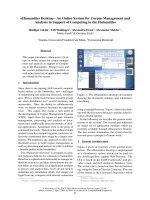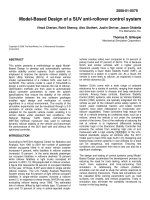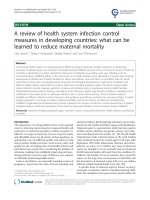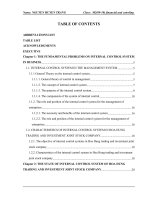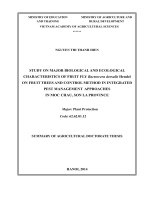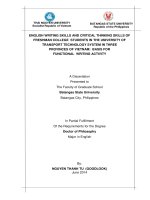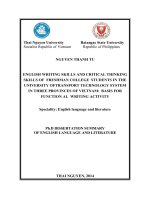Design thinking framework toward management control system in environmental dynamism an innovation perspective
Bạn đang xem bản rút gọn của tài liệu. Xem và tải ngay bản đầy đủ của tài liệu tại đây (3.15 MB, 16 trang )
<span class="text_page_counter">Trang 1</span><div class="page_container" data-page="1">
Design Thinking Framework Toward ManagementControl System in Environmental Dynamism: An
Innovation Perspective
Pratima Verma, Vimal Kumar, Tugrul Daim<i>, Senior Member, IEEE, and Nagendra Kumar Sharma</i>
<i><b>Abstract—Design thinking has been largely acknowledged as a</b></i>
<b>technical advancement in business circles in terms of technology,innovation, creativity, and flexibility. Design techniques are becom-ing more and more popular among organizational executives as acure-all for uncertainty and upheaval, so it is important to takeenvironmental dynamism into account. However, with few excep-tions, design thinking studies are most entrenched in consideringvarious organization factors rather than environmental and controlsystems. The purpose of the present article is to shed insightsinto the relationship between design thinking and managementcontrol systems under the condition of a dynamic setting. Moreover,the article also presents design thinking as a strategic innovationconcept that links to and works to achieve sustainable competitiveadvantage. Further, we develop the framework that hypothesizeddesign thinking relationship to diagnostic and interactive controlsystems (ICSs) in the domain of environmental dynamism andcompetitive advantage. A survey was conducted on research anddevelopment intensive firms varying from manufacturing to ser-vice. The results of this article revealed that design thinking isstrongly linked with ICSs and sustainable competitive advantage.The present article suggests an imperative way toward integrationof the concept of design thinking in businesses while consideringenvironmental factors, given the growing scholarly interest in bothdesign thinking and management control systems. The article alsooffers fruitful research directions and analyzes the ramifications ofsuch directions for theory and practice.</b>
<i><b>Index Terms—Competitive advantage, design, design thinking,</b></i>
<i><small>J. Luo. (Corresponding author: Tugrul Daim.)</small></i>
<small>Pratima Verma is with the Department of Strategic Management, dian Institute of Management Kozhikode, Kozhikode 673570, India (e-mail:).</small>
<small>In-Vimal Kumar is with the Department of Information Management, ChaoyangUniversity of Technology, Taichung 41349, Taiwan (e-mail: ).</small>
<small>Tugrul Daim is with the Portland State University, Portland, OR 97201 USA,and also with the Chaoyang University of Technology, Taichung 41349, Taiwan(e-mail: ).</small>
<small>Nagendra Kumar Sharma is with the Department of Management Studies,Graphic Era (Deemed to be University), Dehradun 248002, India (e-mail:).</small>
<small>Color versions of one or more figures in this article are available at Object Identifier 10.1109/TEM.2023.3238665</small>
significant Information Technology (IT) [11],[18],[135]andBusiness[88]. The business has entered a new period of intensecompetition (hypercompetition) with strong and ruthless rivalry
[34]. Human-centered innovation is achieved through designthinking, which also maintains technological and economicviability, and market leadership [4],[86],[103],[108],[113].Design thinking is now acknowledged to be a mode of thinkingthat results in evolution, innovation [36], and transformation
[132], as well as new ways of pursuing and running a business
[121]. Its theory aids in exploring the creative design process andit is also associated with psychology[30]. This idea was first de-veloped in engineering to help engineering construction becomemore embedded, but business managers are now embracing it asa sympathetic method to comprehend the competitive landscape
[69]. In the view of Zapata-Roldan and Sheikh[132],[36], andRobbins and Fu[108], design thinking is related to new productdevelopment that has become valuable to a firm’s strategy andproduct success. Moreover, it is an organizational capabilitythat, since it fosters cooperation and the growth of a moreuser-centered perspective, can help an organization increase itscapacity for innovation[79],[36].
Existing research on design thinking has been found in severalareas’ information management [8], knowledge management
[93],[113], technology management[87], project management
[123], and business management[88],[89]; and identified eral antecedents, such as innovation [81], [127], innovationperformance[45], design communication[136], strategy[108],
sev-[132], competitive advantage[17],[77], new product ment, social product development[41],[80], and customer needs
develop-[66]. However, recognizing the uncertainty and success level ofthe design thinking implementation phenomenon cannot be fullyanticipated in advance, especially in a technological turbulenceenvironment[81]. In line with this, Hanvanich et al.[55]andYuan et al.[131] also suggested that the degree of dynamismof changes in the environment may influence a firm’s ability toadapt its resources to new requirements.
Hence, the “environment perspective” is important for thecurrent study because design thinking view as a dynamic ca-pability [80],[85] that is also context-dependent[74], [137].Environmental dynamism is described as the frequency, mag-nitude, and general conditions of change in the environment
[131]. Environmental dynamism increases the relevance of ternal knowledge[13]. Additionally, it has been noted that firmsare employing design approaches more frequently to improvetheir research and development (R&D) management innovationprocess as well as a potential panacea during times of uncer-tainty and disruption[108]. Design capability and flexibility arevaluable for innovation in conditions of market or technological
<small>ex-0018-9391 © 2023 IEEE. Personal use is permitted, but republication/redistribution requires IEEE permission.See for more information.</small>
</div><span class="text_page_counter">Trang 2</span><div class="page_container" data-page="2">turbulence in the environment [81]. These studies (e.g.,[13],
[81], and [108]) have drawn attention to environmental namism’s relevance for design thinking. None of the studiesconsidered environmental dynamism with respect to designthinking. The information mentioned above leads to a researchgap regarding the consideration of environmental dynamism.On top of this, Nguyen et al.[96]pointed out the role of designthinking analytical based system in improving the managementcontrol system. The article also considered a management con-trol system based on the theoretical and conceptual clarificationsof environmental dynamism presented above. In the recent past,there is only one study that considered the management controlsystem with respect to design thinking analytical systems inthe baking industry[96]. However, to date, understanding howmanagement control systems relate to design thinking and howit affects design thinking is insufficient or unexplored in thedynamic setting. This not only leaves a research gap but also mayconfuse managers into adopting design thinking according to the
<b>dy-environment. To fill the above research gaps, the first goal of the</b>
present article is to test the relationship between design thinkingand management control system. Moreover, the second goal ofthe article also explores the environmental dynamism role and itsinfluence on design thinking and management control system.
The capability of design thinking creates a competitive vantage in a dynamic setting. For decades, one of the mosthighly lauded and debated subjects in business management hasbeen the creation of long-term competitive advantage. Manyways to achieve competitive advantage[109], which vary fromprofessional branding to planning distribution networks. Orga-nizations highly emphasize innovation because it is one of theways to achieve sustainable competitive advantage. In line withthis, design thinking is one of the ways to pursue innovation
ad-[86],[108],[113]. Design thinking framework helps to createsocial product development that offers a route to a competitiveedge[41]. As per the insights from the resource-based view, if acompany has strategic flexibility, it can preserve its competitiveedge in a changing environment[65]. The article also identifiedthe relationship between sustainable competitive advantage anddesign thinking. This article attempts to fill these gaps in priorresearch in terms of environmental dynamism, managementcontrol system, and competitive advantage by addressing thefollowing research questions:
<i><small>RQ1: How design thinking is related to management control systemsand competitive advantage?</small></i>
<i><small>RQ2: How does environmental dynamism influence design thinkingand control systems relationships?</small></i>
In environment dynamism consideration, the article is larly interested in the stability and uncertainty components of theenvironment. Organizations mainly focus on two managementcontrol systems that are interactive control systems (ICSs) anddiagnostic control systems (DCSs), consequently, the articleconsidered the same. We perform survey research with R&D-intensive companies to address these research questions. Datawere collected through the online survey of the senior executivesince the time was pandemic, and analyzed using the partialleast square (PLS) method. The contributions of this article arethreefold. First, this article contributes to the design thinkingliterature by advancing current knowledge of control systems.It also provides empirical evidence in support of environmentdynamism’s effects on the relationship between the management
particu-control system and design thinking. Finally, building a petitive advantage can be accomplished by utilizing the designthinking phenomena. Design thinking is often discussed in theliterature in relation to engineering, sustainability research, andarchitectural perspectives; however, the current article will beengineering-management-focused, emphasizing design as a cre-ative and strategic activity with an emphasis on environmentaldynamism.
com-The rest of this article is divided into the following sections.The relevant literature on design thinking and managementcontrol system, environmental dynamism, and competitive ad-vantage are presented in SectionII. SectionIII illustrates theresearch methodology adopted for carrying out the analysis. Sec-tionIVgives the study’s data analysis and results. In SectionV,discussion, findings, and contributions to the study were reportedfollowed by the conclusions with limitations and scope of thefuture opportunities in SectionVI.
II. T<small>HEORETICAL</small>B<small>ACKGROUND AND</small>H<small>YPOTHESES</small>
<i>A. Design Thinking and Management Control System: AStrategic and Innovation Perspective</i>
<i>Design thinking and creativity and innovation: Design </i>
think-ing is a relatively new concept in comparison to creativity andinnovation, but all these three concepts are inextricably linkedto each other. Creativity is essential to human intelligence[54].Creativity and newness define the innovation process and arethus highly valued in industry and society[32],[61]. Innovationis the sense of an idea, activity, or object as being novel bya person or other unit of adoption. The innovation aims tocreate new products, services, and systems, new demands, andnew markets[61]. Moreover, innovation enables a business toadapt to changes in markets, technology, and competition[3].In continuation to innovation and creativity, design thinkingis a way to connect it to human- or user-centered innovation,creative problem-solving, experimentation, and iteration[17]. Inthe quest for innovation, design thinking prioritizes human andcreative processes, and it has the ability to “release” the “creativeconfidence” required for the invention[101]. Design thinking,an approach to creativity and innovation based on designers’activities, has gained acceptance in the innovation managementdebate[7]. The human-centered innovation process emphasizesobservation, cooperation, quick learning, idea visualization,rapid concept prototyping, and concurrent business analysisknown as “design thinking,” which has an impact on both inno-vation and strategy[26],[104]. Explicitly, from the innovationperspective, design thinking also connects with various levelsof innovation viz. frugal innovation [127], open innovation
[18], accelerated innovation[81], and disruptive innovation[25].According to[66], traditional design thinking methods start withan innovation challenge; consequently, it is also considered amethodology and a real-world problem-solving approach. It ismainly associated with thinking, which can be seen as a mentalmodel that is linked with value innovation and value generationin an organization[17],[73],[121]. Design thinking helps toimprove the organization’s agility, which helps in rapid response,following continuous change and analyzing the environment
[27]. It is also viewed from a different perspective as manyauthors considered it an innovative approach[26],[95],[104],
[124], as a methodology for solving problems[1],[14],[50],
[110], as skills and capabilities[24],[106], and as a strategy[37],
</div><span class="text_page_counter">Trang 3</span><div class="page_container" data-page="3">[69],[77],[94],[116],[124]. To bring greater value to the marketand accomplish business or mission-related goals, effectivelymanaged design or design management can offer a strategicalternative[132]. When design thinking is applied in a company,it becomes a regular practice that businesses and workers adhereto. As a result, it is similar to routine coordination among staffthat is followed to solve problems, develop new products, andenhance productivity. Design approaches can help engineers,sales staff, internal services, and management become effectivein their work[12].
Management control systems are a notable function within anorganization. It is an intention to motivate managers by control-ling and enabling devices[138], and by rewarding and promotingpeople according to certain criteria to ensure that organizationalobjectives are accomplished[33]. The management control sys-tem examines the configuration of controls in design thinking,including rules, procedures, routines, methods, and practicesthat provide information for decision-making[122]. A collectionof formal and informal mechanisms that help the managementguide the organization toward its objectives can be referred to asthe control system[140].[138],[139]identified two main typesof control systems, i.e., diagnostic and interactive. Diagnosticcontrols are more “conventional” types of control that use a lim-ited number of vital performance factors or KPIs that top man-agement believes are essential for achieving the predeterminedtargets. Decision-makers and managers who employ ICSs, andformal information tools, to talk about strategic uncertainty,promote conversation, and regularly and directly participate inthe decision-making of subordinates [139],[138]. There is astrong relationship between the management control systemand strategy implementation [70], [72], [140], [141]. As wealready mentioned design thinking is also viewed as a strategy.Design thinking has a strong relationship with strategic thinkingwhich is also a strategic phenomenon[100]. Additionally, whenstrategy and innovation are combined with design principles, thesuccess rate for innovation greatly increases. Design thinkinghas several applications and advantages that may be appliedto both strategies[132]and product development [36],[108].The ICS will similarly establish tomorrow’s strategy with theprimary objective of promoting the development of learningorganizations and serving as a reminder to the management ofstrategic uncertainty manifested as issues or opportunities[49].In business, design thinking is also a method of turning strategyinto reality[59]. It is essential for gaining a competitive advan-tage since it directs the organization’s strategy toward goods thatare more valuable than competing options[69]. Of its impact onthe perceived formalization of coordination procedures, the ideaof strategy and innovation is the common thread connecting de-sign thinking and ICSs as a type of management control system
[94]. For the design thinking process, the foremost requirementis to genuinely engage employees or continuously employeeengagement[46], in a similar way interactive use of a controlsystem needs an involvement process[47],[142],[143]. Fromthe above point of view, it makes sense that design thinking andICSs are strongly associated. In the next section, we will discussthe concept of environmental dynamism or environment and itsinfluence on the control system and design thinking.
[59],[69],[72],[77],[98], so the consideration of environmentaldynamism is critically needed but it is still underrepresentedby the scholars. Control is concerned with the procedures theorganization uses to change to fit its environment[68],[145].Making sure that the organization is suited to its environmentand is taking steps that will help it accomplish its goals is theprocess of doing this[146]. This article also tries to explore therole of environmental dynamism in management control systemsand design thinking.
The interactive use of the control system is utilized to broadenopportunity-seeking and learning across the business, as wellas to encourage the creation of new ideas and activities[82].It encourages coordination and communication between em-ployees and employers in the organization. If an environment isstable (static environmental dynamism), then the organization ispreferred to use a DCS where everything is predefined, rigid, andtime-consuming reporting structure but when uncertainties arisethen the organization utilizes an ICS to smooth the functioningof the organization[140]. Both types of control systems may ormay not facilitate the innovativeness to achieve a competitiveadvantage which is depending on the environmental dynamismlevel. The level of environmental dynamism decides to followthe organization’s routine and coordination. According to Yuanet al.[131], the more dynamic the environment, the more likelyit is that the rigidities of existing business models will serve aswarnings (information), compelling companies to use dynamiccapabilities to reshape their outmoded, rigid business models tobetter fit their settings. High environmental dynamism createsunpredictability, which has a direct impact on the organization’sinternal context, possibly increasing levels of stress, anxiety,and risk[125]. While low environmental dynamism means theorganization follows static business models, more boundaries ofcommunication, and inflexibility in routines and coordination.As environments get more dynamic, firms must increasinglyrely on new external knowledge to promote innovation andenhance performance, while in more stable contexts, preexistinginformation and knowledge are less important for assimilatingand understanding recently obtained external knowledge.[13].
</div><span class="text_page_counter">Trang 4</span><div class="page_container" data-page="4">The level of innovation and its performance in an organization isalso affected by environmental dynamism[28],[56],[62],[94],
[118]. When the environment gets more dynamic, particularly interms of competitiveness, consumer preferences, and regulatoryrequirements, organizations focus on their dynamic capabilities.Companies that prioritize design as a strategic component areconsiderably more likely to have implemented each form ofinnovation [126]. The depiction of concepts and the actualexecution of new products and services are two aspects ofhow design thinking is used in company strategy and businesstransformation[29]. Strategic reasons for design thinking it hasa relationship with environmental dynamism. The followingtheories are put out in light of the aforementioned hypothesisand explanation:
<i><small>H1: Design thinking and diagnostic control system are favorablylinked to Static Environmental Dynamism.</small></i>
<i><small>H2: Design thinking and interactive control system are favorablylinked to Dynamic Environmental Dynamism.</small></i>
<i>C. Competitive Advantage (CA)</i>
Creating long-term competitive advantage has been one ofthe most frequently lauded and debated themes in businessmanagement[97]. Porter[147]defined sustainable competitiveadvantage as “a condition where a firm’s competitive advantagesurvives erosion by the actions of its competitors (p. 20).”Market-based model and resource-based theory model are thetwo models that are grounded in economic theory and focuson achieving competitive advantage. A model of the marketis based on price and differentiation, while the resource-basedtheory model focuses on the internal resources of the firms
[107]. A strategy for maintaining an organization’s competitiveposition over the long term that makes the most of availablecapital-raising opportunities while also employing other re-sources is known as a sustainable competitive advantage[148].The industry has entered a new phase of intense competitiveness,marked by aggressive rivalry. Organizations want to followinvention, creativity, innovation, and new ideas because of thefierce competition and evolving technology. In line with this, theconcept of innovativeness is significant for surviving a firm’s life
[149],[23], and it is important for organizational ity[150]. Additionally, firms also must constantly reconfigureinternal resources and skills to adopt corporate responsibilityfor responding to a chaotic environment in order to develop orretain a competitive advantage[34]. As innovativeness, there areseveral ways to gain competitive advantage for an organizationlike IT capability related to agility and indirectly agility relatesto sustainable competitive advantage [109]. Lean productionis also a way to achieve a sustainable completive advantagethrough long-term flexibility[59]; environmental strategies[63];superior customer responsiveness; strategic thinking[151], andentrepreneurial orientation [51]. To better serve their targetcustomers than their rivals, organizations constantly work tohone a core set of competencies, including quality, customerservice, innovation, adaptability, and responsiveness[23]. Theseare traditional but extremely important to generate a competitiveadvantage. As technology evolves and changes the businessecosystem, there are a few modern ways to gain or competitiveadvantage. Design thinking is also one method to achieve it butit is underrepresented in the literature. Businesses have alwaysused strategic thinking to gain a competitive edge for their
<small>sustainabil-Fig. 1.Theoretical framework.</small>
organizations. Design and design thinking have been recognizedas having significant benefits for business and management in thecontemporary environment[89]. The following theories are putout in light of the aforementioned hypothesis and explanation:
<i><small>H3: Design thinking and competitive advantage are favorably linkedregardless of Environmental Dynamism.</small></i>
The theoretical framework is shown in Fig.1.III. R<small>ESEARCH</small>M<small>ETHODS</small>
<i>A. Samples</i>
The article uses a survey approach to collect data in the settingof India. The respondents that were targeted in the article werefrom manufacturing and service firms within the R&D-intensivefirms. A prerequisite for selecting firms based on the presenceof a dominant R&D department in this specific business. Thesurvey was pretested and tested as part of a two-phase datacollection process. In the first phase, we tested the statisticalvalidity of the study’s measures in a pilot study with 30 seniormanagers. The questionnaire was updated to better fit the studyenvironment based on their feedback. The final data analysis didnot contain any of these 30 surveys. Nonprobability sampling,or convenience sampling, was used in the sampling process.This article uses a five-point Likert scale for its measurement,ranging from strongly disagree (1) to strongly agree (5); and usesa five-point Likert extent scale ranging from “to an extremelysmall extent (1)” “to a large extent (5).” Numerous differentactors engaging in humanitarian efforts in nations throughoutAsia make up the empirical context of this article. The durationbetween the distribution of the surveys and their collectionranged from 1 to 10 days. In this article, our primary targetrespondents were senior managers who have been with the samecompany for more than a year to guarantee a strong understand-ing of the organization, therefore helping to improve data quality.The information was gathered between the 4th of October, 2020and the 31st of December, 2021. A total of 396 questionnaireswere distributed, 336 questionnaires have been considered be-cause of considerable missing or incomplete values, and 60surveys were rejected. A total of 127 questionnaires (showing a
</div><span class="text_page_counter">Trang 5</span><div class="page_container" data-page="5"><small>TABLE IMEASURES OFVARIABLES</small>
<small>Fig. 2.Research framework proposed for the article.</small>
response rate of 38%) were valid and useable to conduct the finalanalysis. This sample size was evaluated, found to be suitable,and taken into consideration for the gathering of data and the finalanalysis. The sample covered 36.2% of manufacturing firms and41.7% of service firms, and 22.1% were categorized as others.Respondents had an average working experience in their currentindustries was 5.24 years. These results strengthen our trust inthe accuracy of the data by indicating that the respondents haverelevant experience and understanding of the study’s topics. Atotal of 36.2% of respondents were heads of the R&D, 25% weremanagers at the R&D department, 18.8% of respondents wereleaders in the Product Development Team, and rest 20% of therespondents were members of the key decision-makers groups.The responding firms had an average of 231 employees, and theaverage age of the firms was 21 years. An assessment of theliterature on design thinking, control systems, competitive ad-vantage, and environmental dynamism led to the creation of thesurvey instrument. The questionnaire is entirely in English. Thesuggested framework of the research used in the present articleis shown in Fig.2. All the components (both the independent anddependent variables), assessment scales, and their references arelisted in TableI.
<i>B. Measurement Scale</i>
<i>1) Design Thinking: The scale of design thinking is not</i>
mature enough for organizations. There are only a few studies
exist that can accurately measure design thinking in terms ofcapabilities, practices, and mindset in organizations, such asChesson[24],[152], and[153]. This article measured designthinking as a way of individual mindset, risk, innovation, andbusiness practice with ten items. We adopted a few relevantvariables from[152]and[153], and a few were developed basedon the relevant literature like [36],[103], Liu et al.[81], and
[154]that were considered design thinking.
<i>2) Management Control System: Although prior articles</i>
have developed psychologically sound measurement scales forDCSs and ICSs in this article. The management control systemscales are fairly mature from two perspectives: one assessingthe company’s routine and the other strategic direction of theorganization. In this article, it is measured by the routines of theorganization like decision-making power, flexibility, innovation,tracking the progress of the organization, and monitoring results.The measurement scale of DCSs and ICSs was inspired byvarious studies like Muller-Stewens et al.[94], Lopez-Valeiraset al.[82], and Kober et al.[70]for this article.
<i>3) Environmental Dynamism and Competitive Advantage:</i>
Environmental variables were used to calculate environmentaldynamism, which took into account the influences of the in-dustrial environment, competitor actions, technology advance-ments, and customer expectations. We divided environmentaldynamism into static and dynamic components. Competitiveadvantage may be assessed by comparing the company’s po-sition to that of a competitor. We utilize and developed a fewmetrics to measure competitive advantage from Li and Liu[76],Wang[128], and Chang[22], respectively, in terms of financialand nonfinancial aspects, such as market share, quality, prof-itability, growth rate, and so on. We developed the scale of en-vironmental dynamism from literature like[13],[55],[76], and
IV. A<small>NALYSIS OF</small>D<small>ATA AND</small>R<small>ESULTS</small>
Once the demographic and the scale of measurement sectionwere completed, the present article continued with the analysisof the data. Further, the findings evaluate the diagnosis of thedesign thinking and its relation to other variables like envi-ronmental dynamism, management control system, competitiveadvantage, the measurement model, and the structural modelin the next subsections. Investigating the connections betweendesign thinking and management control systems and how envi-ronmental dynamic affects these connections is the goal of thisarticle. Additionally, the article also explores the relationshipbetween design thinking and sustainable competitive advantage.
</div><span class="text_page_counter">Trang 6</span><div class="page_container" data-page="6"><small>TABLE II</small>
<small>ASSESSMENT OF THESCALEMEASUREMENTMODELWITHITSRELIABILITY ANDVALIDITYVALUES(</small><i><small>N</small></i><small>= 127)</small>
The method for the article was PLS and structural equationmodeling (SEM), which was the requirement of the presentmodel and its characteristics of the variables. The softwareversion of SmartPLS 3.3.3. was used. The PLS-SEM strategywas used by[2],[39], and[53]in their work. This method hasthe obvious benefits of convenience and adaptability.
<i>A. Common Method Variance (CMV) and Nonresponse Bias</i>
Before checking for a significant relationship in the structuralmodel, it was crucial toward ensuring that the measurement scalemodel has sufficient validity levels and reliability levels. Welooked into potential nonresponse bias in the comparison of earlyand late responders using Armstrong and Overton’s[5]methodand found the absence of nonresponsive bias. Furthermore,the collection of responses from the same respondents at thesame time using the common method variance technique wasmeasured using Harman’s single-factor test [102]. When all
indicators were inputted, no one component accounted for thethreshold of 50% variance, showing that there was no significantcommon method bias.
<i>B. Measurement Model Assessment</i>
TableII’s summary of the data shows the mean and standarddeviation (descriptive statistics) of various parameters of designthinking, environmental dynamism, management control sys-tem, and sustainable competitive advantage. With the help of theSPSS application, confirmatory factor analysis was conducted.Before the final analysis, the model fit needs to be checked.The SRMR value <i>= 0.07 (<0.08) shows the perfect model</i>
fit [57]with having chi-square value of 808.656. To evaluateinternal consistency, the reliability (<i>α) test of all the construc-</i>
tions (factors) was computed as it is regarded as one of thesignificant measures for the reliability of the scale. For internalconsistency, a “higher” figure of<i>α (>0.6) is considered suitable.</i>
</div><span class="text_page_counter">Trang 7</span><div class="page_container" data-page="7"><small>Fig. 3.Statistics of the measurement model. Note:</small><i><small>∗</small></i><sub>DT—design thinking; DCS—diagnostic control system; ICS—interactive control system; SCA—sustainable</sub>
<small>competitive advantage; EDD—environmental dynamism (dynamic); and EDS—environmental dynamism (static).</small>
The reliability values in TableIIare substantially greater thanthe permitted ranges, pointing toward the values of measurementfor the items being reliable and consistent for the next phase ofanalysis. A number of measures, including loadings of the factoranalysis, alpha values (Cronbach’s alpha), composite reliabil-ity (CR), variance inflation factor (VIF), and average varianceextracted (AVE), for the factors (constructs), were highlightedusing the PLS-Algorithm. The model incorporates five factors or
<i>constructs as design thinking (n</i>= 6), environmental dynamism
<i>for a dynamic environment (n</i>= 4), environmental dynamism for
<i>a static environment (n</i>= 4), sustainable competitive advantage
<i>(n= 7), ICS (n = 7), and DCS (n = 4). Every factor loading has</i>
been taken into account as more than 0.5[155]. Initially, designthinking had ten items but four items were deleted because oflow factor loading in the first simulation from the measurementmodel, and after that twenty-eight items were considered forfinal analysis considering reliability and validity. Additionally,every loading value was higher than 0.70[52] and 0.70[39],
[53]except ICS2 (0.682), SCA3 (0.698), and SCA7 (0.695),this is the favored value to calculate and take into account factorloadings. According to Hair et al.[53], the VIF values must notbe more than the five-cut-off point, which ensures that there isno multicollinearity among the variables in the structural model.Scale validity was evaluated using additional AVE and CR cal-culations. TableIIdisplays statistics for descriptive analysis andmatching AVE values and CR values for entire constructions’factors. It indicates that design thinking (AVE is 0.708 and CRis 0.935) has calculated a mean of 4.353 with an SD of 0.658,environmental dynamism for the dynamic environment (AVE is
0.656 and CR is 0.884) has calculated a mean of 3.699 with SDof 0.801, environmental dynamism for the static environment(AVE is 0.663 and CR is 0.887) has calculated a mean of 3.108with SD of 0.786, sustainable competitive advantage (AVE is0.560 and CR is 0.899) has scored a mean of 3.7869 with SDof 0.668, ICS (AVE is 0.668 and CR is 0.933) has calculated amean of 3.983 with SD of 0.680, and DCS (AVE is 0.834 andCR is 0.953) has calculated a mean of 4.083 with SD of 0.816.All the variables AVE and CR have a limit (AVE<i>> 0.5) and CR> 0.7).</i>
Additionally, it is known that for confirming the reliabilityof the constructs calculated values of alpha (Cronbach’s alpha)and CR are the imperative steps. Earlier studies[39],[40], and
[53]have shown that these numbers will not be recognized ifthey are lower than the threshold values of 0.7. These priorarticles also suggest that the AVE value is considered above 0.5.The article finds in the analysis that all the AVE values rangebetween 0.560 and 0.834. Hence, it shows to be valid for con-vergence[39]. Fig.3displays the statistics of the measurementmodel.
Six latent factors (constructs) from the proposed researchmodel have thus been supported by the measurement model(DT, EDD, EDS, SCA, ICS, and DCS). R-squared values ofDCS, EDD, EDS, ICS, and SCA are 0.448, 0.150, 0.031, 0.564,and 0.272, respectively, included are path coefficient valuesas well as outer loadings (mentioned in Fig. 3). Last, assessthe discriminant validity of these five constructs’ correlations(as represented in TableIII). All of these items were thereforeaccepted and moved on to the bootstrap analysis stage. To ensure
</div><span class="text_page_counter">Trang 8</span><div class="page_container" data-page="8"><small>TABLE III</small>
that measures of the constructs created for the present article arenot strongly associated with one another, discriminant valid-ity was conducted. In reality, convergent validity coefficientsshould be substantially larger than the discriminant validitycoefficients. Last but not least, discriminant validity establishesif the constructs in the article are substantially associated withone another or not. It contrasts the connection between a certainconstruct and other constructs with the square root of AVE ofthat construct. Common wisdom holds that the square root ofAVE should be greater than the construct’s correlation with otherconstructs (if not, the individual construct does not provide muchdiscrimination, i.e., unique explanatory power). In two differenttechniques, we evaluated the constructs’ discriminant validity. Inthe beginning, factor-squared correlations were contrasted withAVE values for every construct for each factor[42]. The AVEvalues calculated for every factor, as shown in TableII, are higherthan its squared correlations with other factors, supporting thediscriminant validity.
<i>C. Assessment of Structural Model</i>
<i>R</i><small>2</small><i>and Q</i><small>2</small>values are used to first assess and apply the model.The authors’ determination of the structural model’s power ex-
<i>planation is aided by the R-squared (R</i><small>2</small>) value. Weak, moderate,and large degrees of significance can be examined using the four
<i>R</i><sup>2</sup> thresholds of 0.25, 0.50, and 0.75[53],[57]. The results ofthe analysis (presented in Fig.3) are used to calculate the betavalues of all the routes leading from independent variables todependent variables. These are design thinking to static environ-mental dynamism (<i>β = 0.175, p = 0.205), static environmental</i>
dynamism to the DCS (<i>β = −0.052, p = 0.503), design thinking</i>
to dynamic environmental dynamism (<i>β = 0.388, p = 0.001),</i>
dynamic environmental dynamism to the ICS (<i>β = 0.263, p =</i>
0.001), design thinking to sustainable competitive advantage (<i>β= 0.521, p = 0.000). According to the results of PLS (presented</i>
in Fig.3<i>), R</i><small>2</small>values obtained for DCS, ED, ICS, and SCA are0.446, 0.260, 0.560, and 0.345, respectively. Thus, 44.8%, 15%,3.1%, 56.4%, and 27.25%, respectively, explain the endogenousconstruct with the criteria-based significant variance levels. The
<i>PLS-SEM model is assessed using the Q-squared (Q</i><small>2</small>) value.For a structural model’s prediction accuracy to be indicated,
<i>positive Q</i><sup>2</sup> values are required. The model’s minor, medium,and considerable predictive relevance are shown by values of
<i>Q</i><sup>2</sup>that are above 0.00, 0.25, and 0.50, respectively[53],[57].The PLS bootstrapping was considered and the output indi-cates (presented in Fig.4<i>), that Q</i><small>2</small> values for DCS, dynamicenvironmental dynamism, static environmental dynamism, ICS,and sustainable competitive advantage were obtained at 0.359,0.092, 0.009, 0.362, and 0.131 (<i>>0), respectively, demonstrating</i>
a decline in the theoretical performance construct’s predictive
<small>TABLE IV</small>
<small>EFFECTS OFDTONEDSANDDCS [THISTABLEPRESENTS THEMEDIATING</small>
<small>IMPACT OFEDSON THEASSOCIATIONBETWEENDTANDDCS (H1)]</small>
<small>TABLE V</small>
<small>EFFECTS OFDTONEDDANDICS [THISTABLEPRESENTS THEMEDIATING</small>
<small>IMPACT OFEDDON THEASSOCIATIONBETWEENDTANDICS (H2)]</small>
<small>TABLE VI</small>
<small>PREDICTIVERELEVANCE OF THEMEASUREMENTMODEL</small>
value. TableIVshows the effects of DT on EDS and DCS (themediating impact of EDS on the association between DT andDCS for H1) and the effects of DT on EDD and ICS are shownin TableV(the mediating impact of EDD on the associationbetween DT and ICS for H2). Table VIdisplays the model’spredicted relevance.
Measurement of the effects of design thinking and ment control system is the goal of this article to achieve sustain-able competitive advantage to test three hypotheses. Since these
</div><span class="text_page_counter">Trang 9</span><div class="page_container" data-page="9"><small>manage-Fig. 4.Structural model. Note:</small><i><small>∗</small></i><sub>DT—design thinking; DCS—diagnostic control system; ICS—interactive control system; SCA—sustainable competitive</sub>
<small>advantage; EDD—environmental dynamism (dynamic); and EDS—environmental dynamism (static).TABLE VII</small>
<small>RESULTS OFHYPOTHESES</small>
hypotheses were tested, the bootstrapping evaluation was carried
<i>out to highlight the t-statistics which are presented in Fig.</i>4.
<i>In the table-8 number of variables (estimates, t-value, standarderror, and p-value) are presented. The cumulative factors of</i>
sustainable competitive advantage are related to superior ciency, innovation, customer response, technology, and quality.The measurement model with all variables was analyzed with thehelp of the Smart-PLS (version 3.3.3) application. The reliabilityand validity analysis results are shown in Table II. To knowwhether the independent variables in the model are independentor not a multicollinearity test was performed. The results basedon the multicollinearity test it was found that the VIF valuesare under 5 which indicates it is normal. The results of thehypothesis in the article are presented in TableVII, showingthat there is a significant effect of independent variables ondependent variables. This is design thinking for sustainable
<i>effi-competitive advantage (t= 5.251, p = 0.000). Thus, the research</i>
hypothesis (H3) is supported by the evidence and indicates thesignificant factor that lent good support to this article. This
<i>hypothesis is supported due to its p-value which was significant</i>
(<i><0.05 cut-off)</i>[53], so H3 is supported by the evidence. Here,we considered five building blocks of sustainable competitive
advantage viz. superior efficiency, innovation, customer sponse, technology, and quality.
<i>re-D. Mediating Effect</i>
As was previously noted, this article looked into both thedirect and indirect effects of design thinking on DCSs and ICSsutilizing two separate methodologies. As a result, the findingsof this article indicate that design thinking significantly andfavorably influences DCSs (<i>β = 0.663, t-values = 7.592, and p< 0.000), but design thinking does not significantly contribute</i>
to environmental dynamism (static) (<i>β = 0.167, t-values =1.270, and p</i> = 0.205), and environmental dynamism (static)does not significantly contribute to DCSs (<i>β = −0.052, t-values= 0.670, and p = 0.503). The indirect effect of design thinking</i>
on DCSs (<i>β = −0.005, t-values = 0.594, and p = 0.553) means</i>
no mediation but the direct effect is 0.000. Consequently, basedon Mehralian et al.[90], the link between design thinking andDCSs is not mediated by environmental dynamism (static),and the findings do not corroborate H1 about the mediatingimpact.
</div><span class="text_page_counter">Trang 10</span><div class="page_container" data-page="10">Additionally, the impact of design thinking on environmentaldynamism (dynamic) and the ICS was examined utilizing twodistinct methods, including direct and indirect impacts. As aresult, the findings of this article indicate that design thinkingsignificantly and favorably influences environmental dynamism(dynamic) (<i>β = 0.382, t-values = 3.343, and p = 0.001), en-</i>
vironmental dynamism (dynamic) has a significant and positivecontribution to ICS (<i>β = 0.267, t-values = 3.348, and p = 0.001),</i>
and design thinking significantly and positively contributes toICS (<i>β = 0.605, t-values = 8.637, and p = 0.000). The indirect</i>
effect of design thinking on the ICS (<i>β = 0.104, t-values = 2.124,and p</i>= 0.034) means environmental dynamism (dynamic) hasa mediation impact on the relationship between design thinkingand the ICS, and the findings support H2 about the mediatingimpact of Baron and Kenny[10].
V. D<small>ISCUSSION</small>, F<small>INDINGS</small>,<small>AND</small>C<small>ONTRIBUTION TO THE</small>S<small>TUDY</small>
The primary goal of this article was to examine the connectionbetween design thinking and the management control system;second, environmental dynamism influences the relationshipbetween design thinking and the management control system;and third, design thinking is related to sustainable competitiveadvantage. The idea of design thinking is increasingly perme-ating management and opening the door for design to solvenew issues within the company [29]. Through the literaturesurvey, the article explores how design thinking is associatedwith strategic and innovation concepts.
The empirical results provide an intriguing picture of theconnection between design thinking and management controlsystems, and competitive advantage. TableVIIprovides a sum-mary of the results based on the data and analysis. In thisarticle, the management control systems are categorized intotwo forms: ICSs and DCSs. Every organization has its ownculture, structure, and even control system. The managementcontrol system is required for the organization to comprehendhow effectively it satisfies objectives pertaining to productivity,profitability, or efficiency. The article explores the relationshipbetween design thinking and ICS and DCS. The results indicatethat an ICS is interrelated with design thinking in dynamicenvironmental conditions. This result is in line with the re-search of[156]that pointed out design thinking research needsintegration with organizational environments or environmentalfactors. Additionally, the level of environmental dynamism de-cides whether the organization uses ICSs or DCSs with designthinking. Due to this reason, environmental dynamism acts asmediating role between design thinking and ICS. This resultis in line with the research of [120] in which environmentaldynamism had moderating effect between innovation strategyand firm performance. Design thinking promotes flexibilityin the workplace and encourages responsiveness and flexibil-ity to create value ([64], [83], [111]). Additionally, the threefundamental components of design-thinking-flexible space,teamwork, and the design-process-combine form a holistic ap-proach to problem-solving[112]. The interactive use of the con-trol system is utilized to broaden opportunity-seeking and learn-ing across the business, as well as to encourage the creation ofnew ideas and activities[82]. In a similar way, the managementcontrol system in terms of interactive is also closely linked withflexibility, teamwork, and decentralized decision-making powerand the DCS also relates to design thinking but in a static businessenvironment. While low environmental dynamism means theorganization follows static business models, more boundaries of
communication, and inflexibility in routines and coordination.As per the literature survey, few studies support these rela-tionships also, but we fail to justify that statement empirically.Consequently, the analysis shows that H1 is not supported thisarticle.
The third objective which is design thinking is also a way toachieve a competitive advantage. Design thinking is a strategicconcept or mental process that is liable to create innovativenessin an organization ([26],[30],[73],[121]). Moreover, numerousstudies pointed out that innovation is also a source of sustainablecompetitive advantage [23],[51]. Based on the above expla-nation, this article got successfully justified the relationshipbetween design thinking and competitive advantage empiricallyas well as theoretically.
<i>A. Contributions</i>
The outcomes of the article are crucial for the managers andindustry practitioners in the strategy domain specifically thosewho want to adopt the design thinking process in an organization.
<i>1) Contribution to the Theory: The article contributes to the</i>
design thinking theory in several ways. In the past, researchershave considered design thinking as an emerging tool or methodthat assists in a sustainable business model or competitive advan-tage[30],[88],[105]. In this article, the combination of designthinking with management control systems and environmentaldynamism in a new model to discover opportunities withinthis particular concept has a fourfold contribution to theories.It contributes to 1) design thinking can be seen as a strategicand innovative concept ([26];[157], and[106]); 2) the literatureon design thinking; 3) design thinking relates to managementcontrol system under the influence of environmental dynamism([59],[72],[92]); and 4) design thinking source of sustainablecompetitive advantage.
First, by unveiling the design thinking literature review insuch a way that contributes to the innovation theory and strategicconcept. Indeed, the basis of the selection of the other variablewas innovation and strategy. Design thinking is primarily con-nected to a type of thinking, or mental model, that is connectedto value innovation in a company[73],[121]. Its process de-mands genuinely engaging employees or a continuous employeeengagement and involvement process[47],[143]. The articlesupports theoretically all of the above studies.
Second, the article enriches the design thinking ture through the consideration of two kinds of managementcontrol systems, i.e., DCSs and ICSs. These control systems orcoordination routines play a significant role when practicing thedesign thinking concept in the organization. Although there arenumerous organizational capabilities exist that support designthinking, but still none of the studies considered managementcontrol systems.
litera-Third, the article offers a design thinking framework thatexplains the influence and significance of environmental dy-namism on management control systems. The “environmentperspective” is important for the current article because designthinking view as a dynamic capability [80],[85] that is alsocontext-dependent[74],[137]. However, to date, understandinghow management control systems relate to design thinking andhow it affects design thinking is insufficient or unexplored inthe dynamic setting. This article tried to fill this gap through thiscontribution. This model takes into account two perspectives onenvironmental dynamism: one when environmental dynamism
</div>

